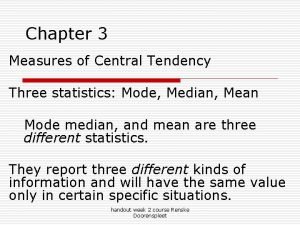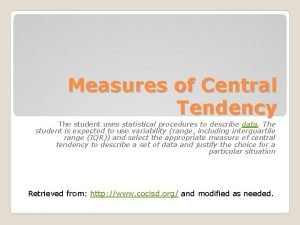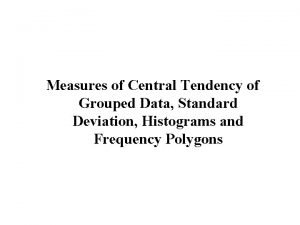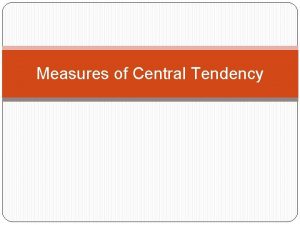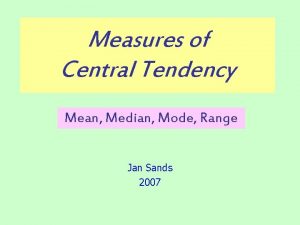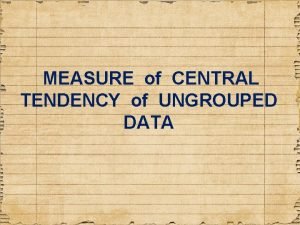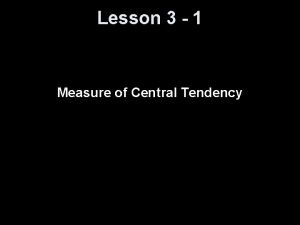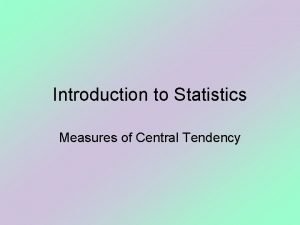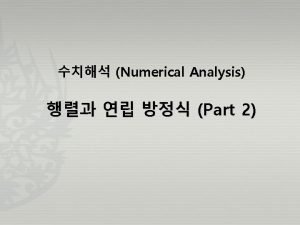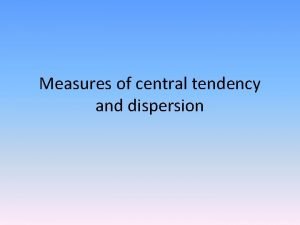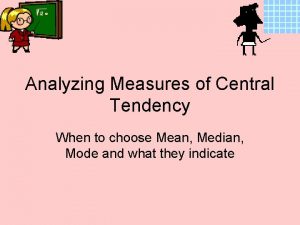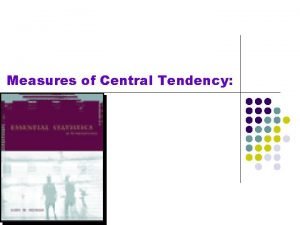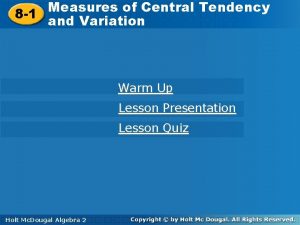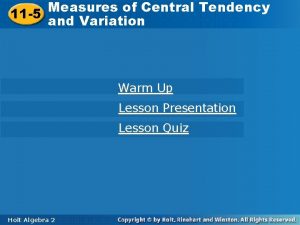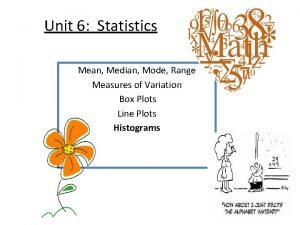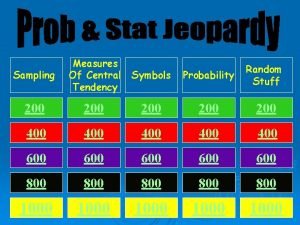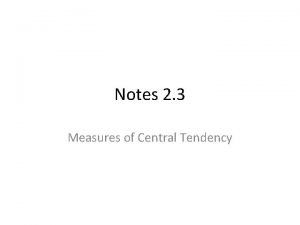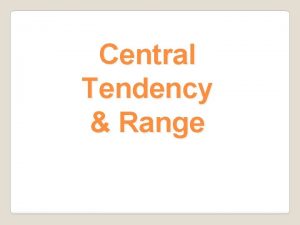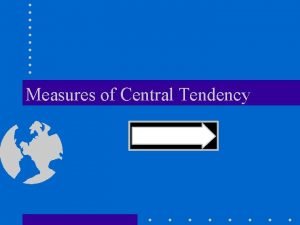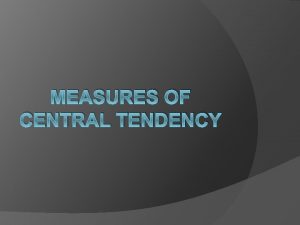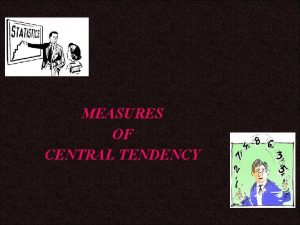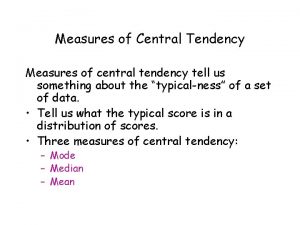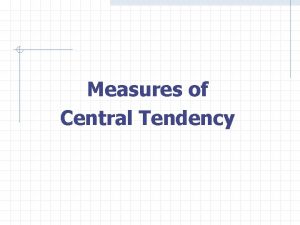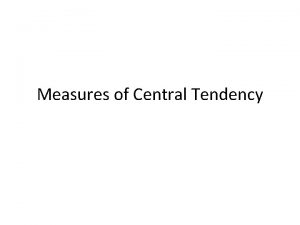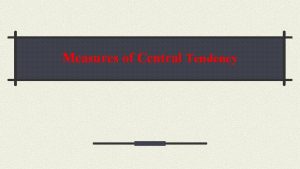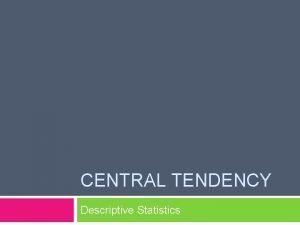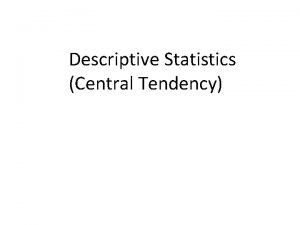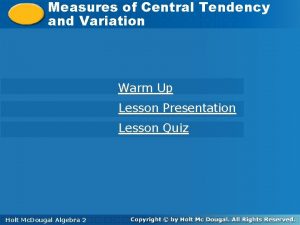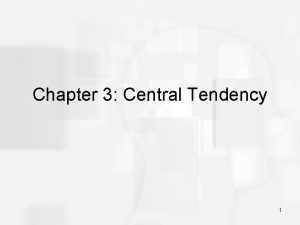Chapter 3 Measures of Central Tendency Three statistics


















- Slides: 18

Chapter 3 Measures of Central Tendency Three statistics: Mode, Median, Mean Mode median, and mean are three different statistics. They report three different kinds of information and will have the same value only in certain specific situations. handout week 2 course Renske Doorenspleet

Mode o o o The most common score. Can be used with variables at all three levels of measurement. Most often used with nominal level variables. handout week 2 course Renske Doorenspleet 2

Finding the Mode 1. 2. Count the number of times each score occurred. The score that occurs most often is the mode. n n If the variable is presented in a frequency distribution, the mode is the largest category. If the variable is presented in a line chart, the mode is the highest peak. handout week 2 course Renske Doorenspleet 3

Finding the Mode “People should live together before marriage. ” Freq. % Agree 864 58. 98 Neutral 227 15. 49 Disagree 374 25. 53 1165 100. 00 handout week 2 course Renske Doorenspleet 4

Median o o o The score of the middle case. Can be used with variables measured at the ordinal or interval-ratio levels. Cannot be used for nominal-level variables. handout week 2 course Renske Doorenspleet 5

Finding the Median 1. 2. Array the cases from high to low. Locate the middle case. n n If N is odd: the median is the score of the middle case. If N is even: the median is the average of the scores of the two middle cases. handout week 2 course Renske Doorenspleet 6

Finding the Median Robbery Rate for 7 Cities Atlanta 1037. 8 Chicago 668. 0 Dallas 582. 8 San Francisco 444. 9 Los Angeles 420. 2 Boston 416. 0 New York 406. 6 handout week 2 course Renske Doorenspleet 7

Finding the Median o How would the median change if we added an 8 th case? n o San Diego had a robbery rate of 145. 3. There are now two middle cases, so the median is the average of the scores of the two middle cases: n (444. 9 + 420. 2)/2 = 432. 55 handout week 2 course Renske Doorenspleet 8

Mean o o o The average score. Requires variables measured at the interval-ratio level but is often used with ordinal-level variables. Cannot be used for nominal-level variables. handout week 2 course Renske Doorenspleet 9

Finding the Mean o o o The mean or arithmetic average, is by far the most commonly used measure of central tendency. The mean reports the average score of a distribution. The calculation is straightforward: add the scores and then divide by the number of scores (N ). handout week 2 course Renske Doorenspleet 10

Finding the Mean Robbery Rate for 7 Cities Atlanta 1037. 8 Chicago 668. 0 Dallas 582. 8 San Francisco Los Angeles Boston New York 444. 9 420. 2 416. 0 406. 6 Total 4121. 6 handout week 2 course Renske Doorenspleet 11

Characteristics of the Mean o o o All scores cancel out around the mean. The mean is the point of minimized variation. The mean uses all the scores. handout week 2 course Renske Doorenspleet 12

Every Score in the Distribution Affects the Mean o o Strength - The mean uses all the available information from the variable. Weaknesses n n The mean is affected by every score. If there are some very high or low scores, the mean may be misleading. handout week 2 course Renske Doorenspleet 13

Means, Medians, and Skew o When a distribution has a few very high or low scores, the mean will be pulled in the direction of the extreme scores. n n For a positive skew, the mean will be greater than the median. For a negative skew, the mean will be less than the median. handout week 2 course Renske Doorenspleet 14

Means, Medians, and Skew o When an interval-ratio variable has a pronounced skew, the median may be the more trustworthy measure of central tendency. handout week 2 course Renske Doorenspleet 15

Use Mode When: 1. 2. 3. Variables are measured at the nominal level. You want a quick and easy measure for ordinal and interval-ratio variables. You want to report the most common score. handout week 2 course Renske Doorenspleet 16

Use Median When: 1. 2. 3. Variables are measured at the ordinal level. Variables measured at the intervalratio level have highly skewed distributions. You want to report the central score. The median always lies at the exact center of a distribution. handout week 2 course Renske Doorenspleet 17

Use Mean When: 1. 2. 3. Variables are measured at the interval-ratio level (except for highly skewed distributions). You want to report the typical score. The mean is “the fulcrum that exactly balances all of the scores. ” You anticipate additional statistical analysis. handout week 2 course Renske Doorenspleet 18
 Statistics chapter 3 measures of central tendency
Statistics chapter 3 measures of central tendency Measures of central tendency
Measures of central tendency Measures of central tendency grouped data
Measures of central tendency grouped data Objectives of measures of central tendency
Objectives of measures of central tendency Range in central tendency
Range in central tendency Measures of central tendency of ungrouped data
Measures of central tendency of ungrouped data Objectives of central tendency
Objectives of central tendency Measures of central tendency
Measures of central tendency Quartile calculator for grouped data
Quartile calculator for grouped data Lu 분해 예제
Lu 분해 예제 Central tendency and dispersion
Central tendency and dispersion Central tendency worksheet
Central tendency worksheet Central tendency symbols
Central tendency symbols How to calculate mode for grouped data
How to calculate mode for grouped data Central tendency and variation
Central tendency and variation Measures of central tendency and variation
Measures of central tendency and variation Unit 6 review #2 - measures of central tendency
Unit 6 review #2 - measures of central tendency Central tendency symbols
Central tendency symbols Measures of central tendency notes
Measures of central tendency notes
